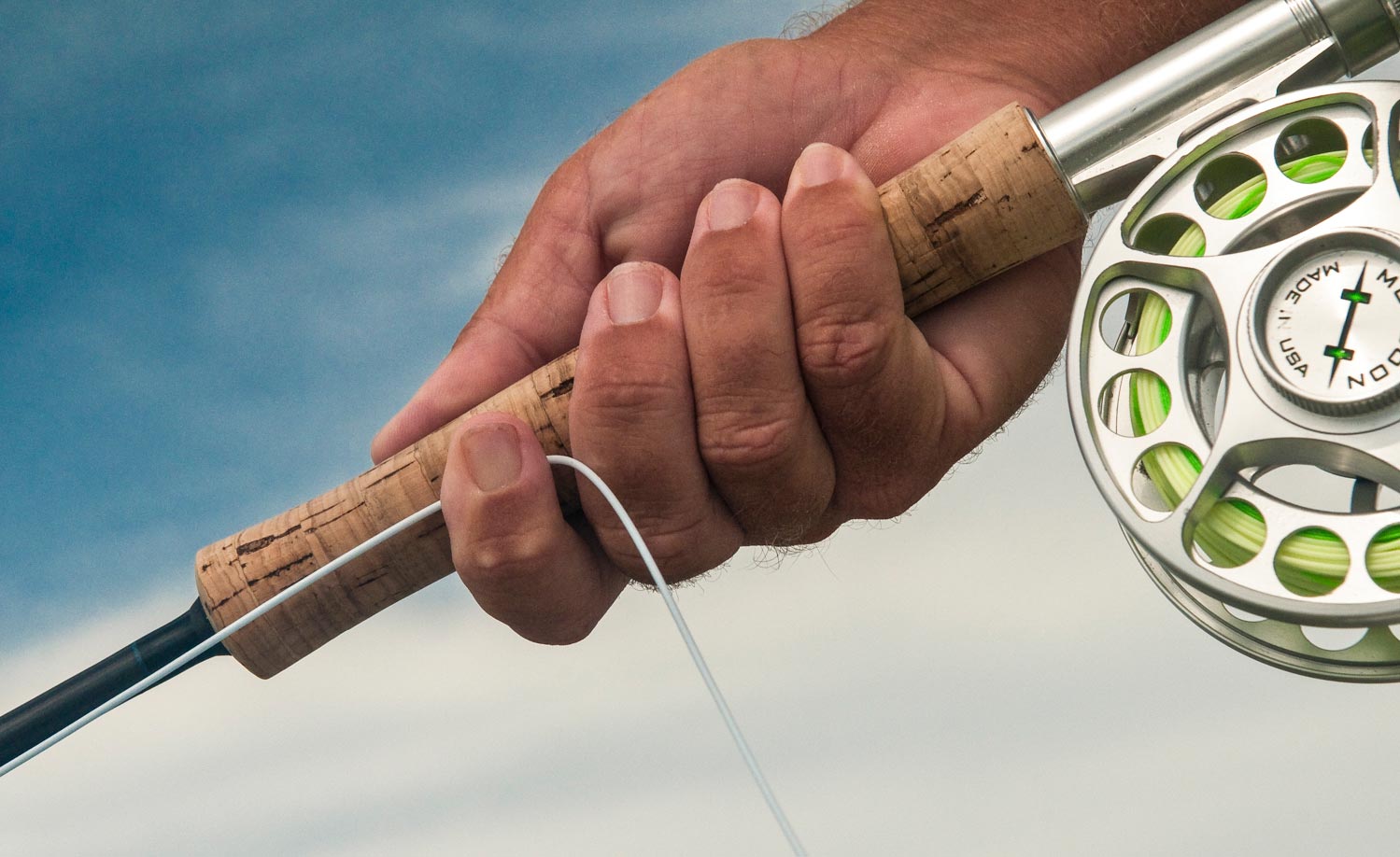Picture yourself grasping a broomstick and driving in a tack with your thumb.
I get the opportunity to work with a lot of anglers who are making the transition from freshwater fly fishing to saltwater. Not surprisingly, most of them struggle with generating the casting power needed to deliver a good presentation in the kind of wind often experienced in flats fishing. Almost everyone has the same pesky problem. They try to generate a more powerful cast and everything breaks down. The problem is not in their arm or elbow or wrist, but in their head.
It’s a problem of understanding the mechanics of the cast. It seems logical to think that more power in means more power out and I guess that’s true but there is a common misconception about where that power is coming from. Most anglers, when trying to add power to a cast, focus on the fly or the line. They visualize throwing that line to the target. The result is a casting stroke that resembles a pitcher throwing a baseball. Including the wind up in the worst cases.
This imagined model of throwing a static object puts all the wrong physics in play for a good fly cast. The resulting casting stroke relies too heavily on the arm and takes the rod out of play. Our instinct tells us to throw harder but the arm is a poor tool for throwing a fly line and our cast fails. The answer to a powerful fly cast is timing and technique, not power.
I’m going to give you a simple tool to help generate a powerful cast but first let’s look at the mechanics.
The fly cast is all about the transfer of energy from our hand to the line. An energized fly line will cut the wind, deliver a fly with accuracy and will not tangle. The tool we use to energize the line is a fly rod. Think of the rod as a guitar amplifier. The physics of how they work is surprisingly similar. There is an inherent energy stored in the fly rod. We use that energy (the flex of the rod) to amplify the signal from our hand and translate it to a wave form which is stored in the line (the loop).
So in this model the signal is initiated by the hand, amplified by the rod and the resulting wave is the loop in our line. If we want to play louder we have two options. Volume and gain. What most of us do when we try to add power to a cast is turn up the gain. This is like putting an overdrive pedal between the guitar and amplifier. The sound is louder, but badly distorted. Great for metal, bad for fly fishing. If you haven’t guessed, that overdrive pedal is your arm. Trying to add power to the cast using your arm results in a distorted signal which means a sloppy deformed loop. No real power.
To get a clean powerful signal we want to use the natural power of our amplifier. The fly rod. The force that energizes the line is the natural energy of the rod. It’s recovery from a flexed position to a relaxed position. That flex is what we call the load. The more flex, the deeper the load. The deeper the load, the more power is stored in the line. By keeping our arm motion under control and using the load of the rod we are able to deliver both power and control.
I can geek out about the physics of fly casting a lot further but I’ll spare you. Here’s what you need to know.
 It’s all about focus. Martial artists control the complex mechanics of their form through focus. They use meditation as a tool to isolate and concentrate on key points of the body’s complicated systems. When energy is focused on these points, the rest of the system falls in line. The same idea applies to fly casting and, with a thumb-on-top grip, the point we should be focusing on is the thumb.
It’s all about focus. Martial artists control the complex mechanics of their form through focus. They use meditation as a tool to isolate and concentrate on key points of the body’s complicated systems. When energy is focused on these points, the rest of the system falls in line. The same idea applies to fly casting and, with a thumb-on-top grip, the point we should be focusing on is the thumb.
I’m not suggesting that you sit in a lotus position, thinking about your cast while your buddy whacks you with a 10 weight but some simple visual exercises can make a real difference in your casting.
Picture yourself grasping a broomstick and driving in a tack with your thumb. Imagine that you are stepping on the bristles of the broom so it can’t move. You want the pressure to be smooth and controlled so the tack goes in straight. As you press the tack in, squeeze with your pinky to use the leverage of your hand. Picture it very slowly at first, then faster until you’re driving that tack like a nail gun.
I like this metaphor because it reinforces a good straight line rod path which will make a tight loop. Remember, your thumb is the focus point. It’s like the foot on the accelerator. When you feel the line straighten and its weight start to load the rod, focus on the thumb and drive the cast like you’d drive that tack. You’ll like the results.
Timing is also crucial to a good cast. I’d recommend that you check out Capt. Joel Dickey’s line speed drill (HERE) and practice it as well. You’ll be amazed at how much power you can add to your cast and whether you’re fishing in freshwater or salt, a better cast usually means more fish.
Louis Cahill Gink & Gasoline www.ginkandgasoline.com hookups@ginkandgasoline.com Sign Up For Our Weekly Newsletter!

I like your reference to martial arts in your article. I have studied Aikido for 30 years, have taught for 12 and have used its sense of timing and body movement in my own casting.
Thanks for sharing.
Mark White
Thank you for an excellent article. I agree with every point. However, at 75 years of age I have severe arthritis at the base of my right thumb (the casting hand) and I cannot apply much pressure with my thumb or for very long. Do you have a technique for casting with nearly as much force using either the thumb at the side of the grip or the older style with the index finger on the top the grip?
There is a technique called the V grip that is in fact a powerful method of casting and could be very useful in your situation. It takes a bit of getting use to it, but once you do it’s very effective. Bruce Chard has a very good video on explaining it and its benefits, which you can view on the following link. You will need to cut n’paste this link.
https://tinyurl.com/y3gvbkqu
The index finger on top is not a power cast, but an accuracy cast. Literally pointing the index finger at the target as a sighter. Probably better suited to rods in the AFTM rating of 1 – 4. Trust this helps.
hello,
years ago i developed a similar problem with my thumb, and began casting with forefinger on top, as you do. the mental image i use to transfer power from hand to rod is a dart throw.
give it a try- better yet, go to my website and see my latest blog re the mental image of casting.
take care,
al
Thanks for the article. I wished my high school physics teacher used fishing analogies. I would have learned more. If it’s really hard for someone to break bad habits, would you ever recommend someone taping their thumb on the rod so they can’t move it?
In a previous comment I alluded to my long standing study of Aikido and how it has helped me with fly casting. I may have a solution for your arthritis thumb it will be hard to explain and some may think I’m crazy. It will be familiar to those who may have had martial arts training with weapons especially the sword.
Instead of grabbing your rod handle with your hand as usual, place the heel of your hand on the top of your rod handle and wrap your fingers around the handle starting with the little finger. This will create a spiral motion. The thumb will come to naturally rest on top of the handle as in the standard “key grip”. This does 2 things: most of the power of the grip is coming from the fingers allowing the thumb to “rest” on top. It also engages the muscles and tendons in the forearm to give you more strength without added muscle. This is very much how you hold a bokken, a Japanese wooden sword – a relaxed but strong grip.
Hope this helps. M
Do I grab the top of the broomstick?
Do I have my thumb aligned with the length of the broom or off to the side?
I am not sure this gives me enough to go on – and I wish it did! 😉
“Picture yourself grasping a broomstick and driving in a tack with your thumb.”
Yes, there is a technique called the V grip. Here’s a video link to Bruce Chard’s excellent explanation of it. You may need to cut n’paste this to your browser.
https://www.youtube.com/watch?v=pOEATf1hHb8
It takes some getting used to, but is very effective when you do. The finger on top grip was really designed for accuracy casting with light rods i.e. point the finger at the target. Not really a power casting grip.
Hope this helps. As we get older we have to take so many factors into consideration to keep getting those lines out there!
Many thanks!
Pingback: Achieving a Powerful Cast | MidCurrent
Pingback: Achieving a Powerful Cast – Buy Everything Outdoors
Pingback: Achieving a Powerful Cast – Epic Soul Fishing